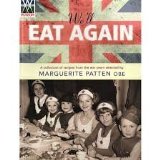 I found myself really craving salad today. Maybe it was something to do with the fact we’ve only got a few more days of sunshine forecast before the temperatures start to drop below freezing. I’ve been limiting myself to tried and true winter vegetables so far, but when I had another look at the vegetables in season, I noticed spinach. Yes! Something green and salad-y. But it’s still ‘wartime’ and I had about 2 ozs of turkey and mashed carrots left over from the weekend, so I really had to use them up.
I found myself really craving salad today. Maybe it was something to do with the fact we’ve only got a few more days of sunshine forecast before the temperatures start to drop below freezing. I’ve been limiting myself to tried and true winter vegetables so far, but when I had another look at the vegetables in season, I noticed spinach. Yes! Something green and salad-y. But it’s still ‘wartime’ and I had about 2 ozs of turkey and mashed carrots left over from the weekend, so I really had to use them up.
The solution? Turkey ‘burger’ (1 medium mashed potato, small amount of chopped fried leek and chopped up cooked turkey meat all mixed together, shaped into a burger and then fried in a little butter) with carrots, spinach, blackberries and a little chopped apple on the side. It’s funny… just a few odds and ends yet it made a really nice lunch. In fact, it made two ‘burgers’ so I have leftovers for tomorrow. More importantly, I really enjoyed my salad! Yay!
 Rather than comment on what was in ‘today’s paper’ on October 24th, 1944, I thought I’d let you in on a conversation I had with Anne this morning.
Rather than comment on what was in ‘today’s paper’ on October 24th, 1944, I thought I’d let you in on a conversation I had with Anne this morning.
It’s been interesting seeing the blackout times in the paper get longer and longer now that they were going into the winter months, so I asked Anne about it. Basic questions like, what was the blackout made of? What did it feel like once the blackout was up for the night?
The blackout was made of a black material that went inside the normal curtains next to the window. Once it was blackout hours, you couldn’t turn a light on in a room without ensuring the blackout curtains were closed, which often meant stumbling across the room in pitch darkness first. She can’t remember if coupons were needed to buy the material, but it was cheaper to buy than other fabrics. And she can remember some people making clothes out of it.
Outside, you could use a torch, but it had to be taped so only a small beam of light showed. The same with car lights.
Which got me wondering what it was like to be outside in the blackout when there was a fog. Even I can remember the filthy smogs we had in Glasgow back in the 60s, and having to go to school with a scarf over my face to protect my lungs. What must fog have been like during the blackout? Anne’s reply was that the fog didn’t just spoil your vision, but also your hearing. It was the absence of sound that she says she hated more than anything. You’d be standing at the bus stop waiting for the bus and have no sense of it until it loomed out of the fog less than ten yards from you.
She has a particular memory of being sent to the chemist’s shop to pick up a prescription for her parents. It was only a few steps away from their flat in Byres Road in Glasgow, but she especially hated going there when there was a fog outside. The 40s was still a time when chemists prepared their own pills and potions, so there were always vapours hanging in the air inside the shop which seemed to affect her particularly badly when she went back out into the fog, burning her throat. She’d run home to the kitchen and the fire where the family congregated. Not only did fire keep the fog away, but with fuel rationed, it was the only room they were able to keep warm. “Everyone lived in the kitchen,’ she said.
We discussed a few other wartime nuggets – little things that you can’t find in the history books – but I’ll keep them until tomorrow.














